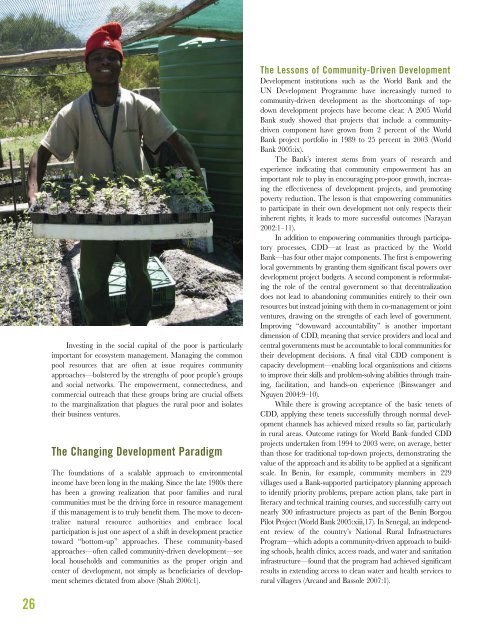Growing the Wealth of the Poor - World Resources Institute
Growing the Wealth of the Poor - World Resources Institute
Growing the Wealth of the Poor - World Resources Institute
Create successful ePaper yourself
Turn your PDF publications into a flip-book with our unique Google optimized e-Paper software.
Investing in <strong>the</strong> social capital <strong>of</strong> <strong>the</strong> poor is particularlyimportant for ecosystem management. Managing <strong>the</strong> commonpool resources that are <strong>of</strong>ten at issue requires communityapproaches—bolstered by <strong>the</strong> strengths <strong>of</strong> poor people’s groupsand social networks. The empowerment, connectedness, andcommercial outreach that <strong>the</strong>se groups bring are crucial <strong>of</strong>fsetsto <strong>the</strong> marginalization that plagues <strong>the</strong> rural poor and isolates<strong>the</strong>ir business ventures.The Changing Development ParadigmThe foundations <strong>of</strong> a scalable approach to environmentalincome have been long in <strong>the</strong> making. Since <strong>the</strong> late 1980s <strong>the</strong>rehas been a growing realization that poor families and ruralcommunities must be <strong>the</strong> driving force in resource managementif this management is to truly benefit <strong>the</strong>m. The move to decentralizenatural resource authorities and embrace localparticipation is just one aspect <strong>of</strong> a shift in development practicetoward “bottom-up” approaches. These community-basedapproaches—<strong>of</strong>ten called community-driven development—seelocal households and communities as <strong>the</strong> proper origin andcenter <strong>of</strong> development, not simply as beneficiaries <strong>of</strong> developmentschemes dictated from above (Shah 2006:1).The Lessons <strong>of</strong> Community-Driven DevelopmentDevelopment institutions such as <strong>the</strong> <strong>World</strong> Bank and <strong>the</strong>UN Development Programme have increasingly turned tocommunity-driven development as <strong>the</strong> shortcomings <strong>of</strong> topdowndevelopment projects have become clear. A 2005 <strong>World</strong>Bank study showed that projects that include a communitydrivencomponent have grown from 2 percent <strong>of</strong> <strong>the</strong> <strong>World</strong>Bank project portfolio in 1989 to 25 percent in 2003 (<strong>World</strong>Bank 2005:ix).The Bank’s interest stems from years <strong>of</strong> research andexperience indicating that community empowerment has animportant role to play in encouraging pro-poor growth, increasing<strong>the</strong> effectiveness <strong>of</strong> development projects, and promotingpoverty reduction. The lesson is that empowering communitiesto participate in <strong>the</strong>ir own development not only respects <strong>the</strong>irinherent rights, it leads to more successful outcomes (Narayan2002:1–11).In addition to empowering communities through participatoryprocesses, CDD—at least as practiced by <strong>the</strong> <strong>World</strong>Bank—has four o<strong>the</strong>r major components. The first is empoweringlocal governments by granting <strong>the</strong>m significant fiscal powers overdevelopment project budgets. A second component is reformulating<strong>the</strong> role <strong>of</strong> <strong>the</strong> central government so that decentralizationdoes not lead to abandoning communities entirely to <strong>the</strong>ir ownresources but instead joining with <strong>the</strong>m in co-management or jointventures, drawing on <strong>the</strong> strengths <strong>of</strong> each level <strong>of</strong> government.Improving “downward accountability” is ano<strong>the</strong>r importantdimension <strong>of</strong> CDD, meaning that service providers and local andcentral governments must be accountable to local communities for<strong>the</strong>ir development decisions. A final vital CDD component iscapacity development—enabling local organizations and citizensto improve <strong>the</strong>ir skills and problem-solving abilities through training,facilitation, and hands-on experience (Binswanger andNguyen 2004:9–10).While <strong>the</strong>re is growing acceptance <strong>of</strong> <strong>the</strong> basic tenets <strong>of</strong>CDD, applying <strong>the</strong>se tenets successfully through normal developmentchannels has achieved mixed results so far, particularlyin rural areas. Outcome ratings for <strong>World</strong> Bank–funded CDDprojects undertaken from 1994 to 2003 were, on average, betterthan those for traditional top-down projects, demonstrating <strong>the</strong>value <strong>of</strong> <strong>the</strong> approach and its ability to be applied at a significantscale. In Benin, for example, community members in 229villages used a Bank-supported participatory planning approachto identify priority problems, prepare action plans, take part inliteracy and technical training courses, and successfully carry outnearly 300 infrastructure projects as part <strong>of</strong> <strong>the</strong> Benin BorgouPilot Project (<strong>World</strong> Bank 2005:xiii,17). In Senegal, an independentreview <strong>of</strong> <strong>the</strong> country’s National Rural InfrastructuresProgram—which adopts a community-driven approach to buildingschools, health clinics, access roads, and water and sanitationinfrastructure—found that <strong>the</strong> program had achieved significantresults in extending access to clean water and health services torural villagers (Arcand and Bassole 2007:1).26
















